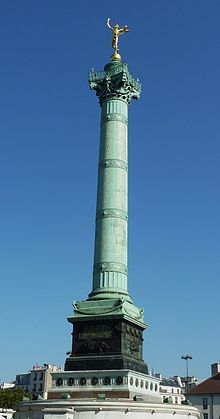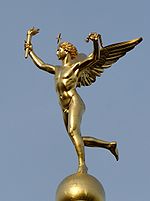July column
The July column ( French Colonne de Juillet ) is a monument on the Place de la Bastille in the 11th arrondissement of Paris .
History of origin

In the place of the July column stood the Bastille city gate castle , which served as a prison until 1789 , the demolition of which began on July 16, 1789 during the French Revolution and was completed on October 4, 1790. The building contractor Pierre-François Palloy, who was in charge of the demolition, laid the foundation stone of the Freedom Column here on July 14, 1792 , but the realization did not get beyond the laying of the foundation stone. On December 2, 1808, the foundation stone was laid for a well with a bronze 24-meter-high elephant ( elephant of the Bastille ), which, however, only reached a model stage made of wood and plaster. This model remained on the edge of the square from 1814 to 1846 and was demolished in September 1846.
In the meantime, a royal decree of July 6, 1831 ordered the construction of the July column in its present form. It was intended to commemorate the "three glorious days" (July 27 to July 29, 1830) of the July Revolution in 1830, which led to the overthrow of Charles X in France and the establishment of the "citizen king" Ludwig Philipp (" July Monarchy ") . Ludwig Philipp commissioned it in 1833. The names of 504 Parisians who perished during the July battles are engraved in gold on a 52 meter high copper column. In 1833 Augustin-Alexandre Dumont created a 5.85 meter high gold-leaf figure that depicts the “spirit of freedom” ( French: Le Génie de la Liberté ) balanced on one leg and that is reminiscent of the street battles of the July Revolution of 1830. The spirit of freedom holds aloft the torch of freedom and the broken chain of tyranny. The figure designed as an angel was placed on the pillar. It is located on a base that was originally intended to hold the sculpture of the elephant in the center.
The inauguration of the entire work of the July column took place on July 28, 1840. After a memorial service on July 29, 1840 in the church of St-Germain-l'Auxerrois, the remains of the fallen, brought together from several mass graves, were brought to the Place de la Bastille with a team of 24 horses and to a temple built especially for this purpose below the July column placed. In March 1848, the column was consecrated as a memorial for the February Revolution of February 22, 23 and 24, 1848. Under the column are the vaults with graves from that time, which are now open to the public.
location
Metro lines 1 , 5 (both Bastille stops ) and 8 ( Chemin Vert ) are located near Place de la Bastille .
Web links
Individual evidence
- ↑ Knowledge for everyone . In: Spiegel Geschichte , 1/2010, p. 60
- ↑ Dieter Bingen / Hans-Martin Hinz (eds.): The razing, destruction and reconstruction of historical buildings ., 2005, p. 25
- ^ Mareike Windel (Ed.): France . 2009, p. 95
- ^ Francia: Research on Western European History . German Historical Institute Paris, Volume 41, 2014, p. 191
Coordinates: 48 ° 51 '11.3 " N , 2 ° 22' 8.7" E

